Unit 5 Lesson 4 导学案
- 格式:doc
- 大小:45.50 KB
- 文档页数:3
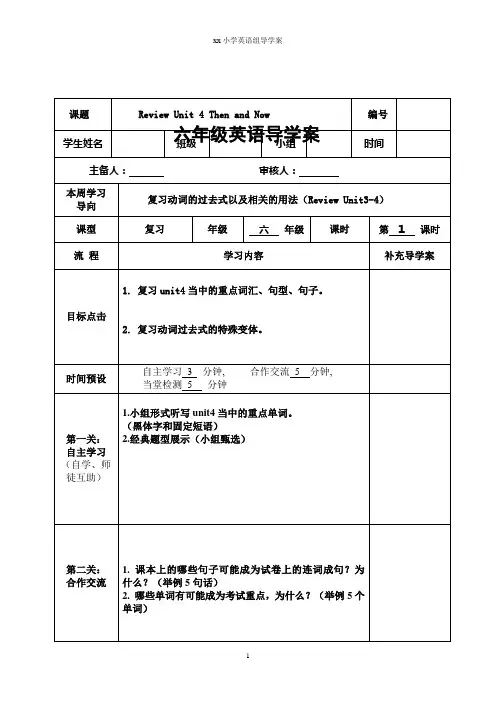
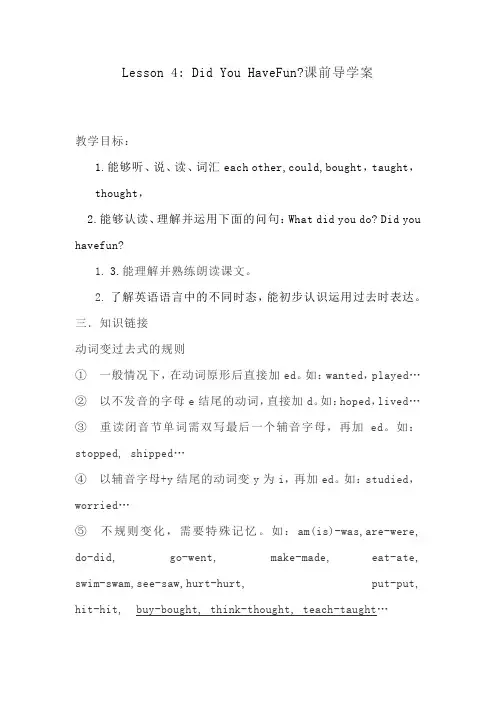
Lesson 4: Did You HaveFun?课前导学案教学目标:1.能够听、说、读、词汇each other,could,bought,taught,thought,2.能够认读、理解并运用下面的问句:What did you do? Did you havefun?1.3.能理解并熟练朗读课文。
2.了解英语语言中的不同时态,能初步认识运用过去时表达。
三.知识链接动词变过去式的规则①一般情况下,在动词原形后直接加ed。
如:wanted,played…②以不发音的字母e结尾的动词,直接加d。
如:hoped,lived…③重读闭音节单词需双写最后一个辅音字母,再加ed。
如:stopped, shipped…④以辅音字母+y结尾的动词变y为i,再加ed。
如:studied,worried…⑤不规则变化,需要特殊记忆。
如:am(is)-was,are-were, do-did, go-went, make-made, eat-ate, swim-swam,see-saw,hurt-hurt, put-put, hit-hit, buy-bought, think-thought, teach-taught…四.学习导航I. 课前完成1.复习1.2.3课,想一想Danny,Jenny和Li Ming做过的事情。
2.预习:勾出不会的单词、词组;利用字典等工具学新词。
3.想一想,写一写:bought(原型)__________ taught(原型)__________ thought (原型)_________bought,taught和thought这三个过去式在发音和书写上有什么异同?怎么快速记住这三组原型和对应的过去式?II. 课后练习A.A. 写一写,根据课文内容填空Jennyand Li Ming _______ fun today. They _______ to a shop . Li Ming _______ aT-shirt today.Theyplayed ping-pong. Li Ming _______Jenny to hit the ball, but he _______ hishand.They_______ basketball, too. Jenny _______Li Ming to throw and catch the ball. LiMing is a good basketball player! Danny _______ the basketball was too _______.He played basketball _______ a ping-pongball.A.B. 我能用动词的正确形式填空B.1. Ioften_________(play) ping-pong with my father.C.2. Healways_________(teach)Danny to skate after school.D.3. Yesterdaymy grandmother_________(go) to thesupermarket.E.4. TomorrowI am going to_________(fly) a kite in the park.F.C. 写出下列动词的过去式G.1.walk____________2.play____________3.learn____________4.is__________H.5.are____________6.do____________7.buy____________8.eat____________I.9.see__________10.go____________11.teach____________12.think________J.13.hit_________14.want__________15.like____________16.sh op__________D.Write about your winter holiday.用过去时写写你的寒假.________________________________________________________ __________________________________________________________ __。
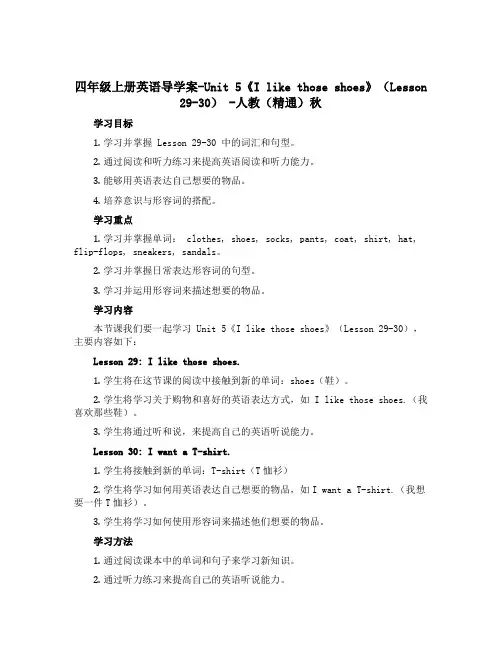
四年级上册英语导学案-Unit 5《I like those shoes》(Lesson29-30) -人教(精通)秋学习目标1.学习并掌握 Lesson 29-30 中的词汇和句型。
2.通过阅读和听力练习来提高英语阅读和听力能力。
3.能够用英语表达自己想要的物品。
4.培养意识与形容词的搭配。
学习重点1.学习并掌握单词: clothes, shoes, socks, pants, coat, shirt, hat, flip-flops, sneakers, sandals。
2.学习并掌握日常表达形容词的句型。
3.学习并运用形容词来描述想要的物品。
学习内容本节课我们要一起学习 Unit 5《I like those shoes》(Lesson 29-30),主要内容如下:Lesson 29: I like those shoes.1.学生将在这节课的阅读中接触到新的单词:shoes(鞋)。
2.学生将学习关于购物和喜好的英语表达方式,如 I like those shoes.(我喜欢那些鞋)。
3.学生将通过听和说,来提高自己的英语听说能力。
Lesson 30: I want a T-shirt.1.学生将接触到新的单词:T-shirt(T恤衫)2.学生将学习如何用英语表达自己想要的物品,如I want a T-shirt.(我想要一件T恤衫)。
3.学生将学习如何使用形容词来描述他们想要的物品。
学习方法1.通过阅读课本中的单词和句子来学习新知识。
2.通过听力练习来提高自己的英语听说能力。
3.小组合作讨论,通过实践来掌握相关的语言知识。
4.培养自己主动学习的习惯。
学习步骤第一步:阅读课文阅读并理解课文,注意语音语调。
每个小组都需要至少两位同学阅读课本中的对话并轮流朗读。
第二步:学习新单词学习本课的新单词,掌握它们的发音以及基本词义。
第三步:学习表达方式学习本课的句子和表达方式,理解其意思。
通过小组合作,让每个同学都能使用英语表达出自己喜欢的物品以及表示想要的物品。
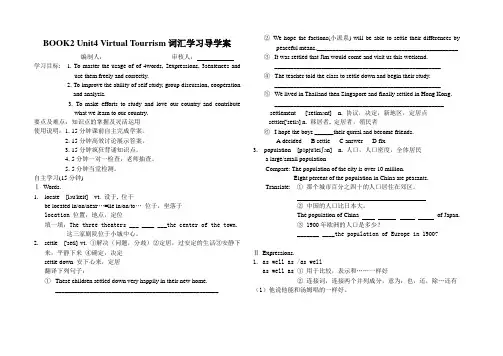
BOOK2 Unit4 Virtual Tourrism词汇学习导学案编制人:审核人:学习目标: 1. To master the usage of of 4words, 2expressions, 3sentences and use them freely and correctly.2. To improve the ability of self study, group discussion, cooperationand analysis.3. To make efforts to study and love our country and contributewhat we learn to our country.要点及难点:知识点的掌握及灵活运用使用说明:1. 15分钟课前自主完成学案。
2. 15分钟高效讨论展示答案。
3. 15分钟疯狂背诵知识点。
4. 5分钟一对一检查,老师抽查。
5. 5分钟当堂检测。
自主学习(15分钟)ⅠWords.1.locate [ləu'keit] vt. 设于, 位于be located in/on/nea r…=lie in/on/t o…位于,坐落于location 位置,地点,定位填一填:The three theaters ___ ____ ___the center of the town.这三家剧院位于小城中心。
2.settle ['setl] vt.①解决(问题,分歧)②定居,过安定的生活③安静下来,平静下来④确定,决定settle down 安下心来,定居翻译下列句子:①These children settled down very happily in their new home.____________________________________________________②We hope the factions(小派系) will be able to settle their differences bypeaceful means._____________________________________________③It was settled that Jim would come and visit us this weekend._____________________________________________________④The teacher told the class to settle down and begin their study._____________________________________________________⑤We lived in Thailand then Singapore and finally settled in Hong Kong.______________________________________________________settlement ['setlmənt] n. 协议,决定,新地区,定居点settler['setlə] n. 移居者, 定居者,殖民者⑥I hope the boys ______their qurral and become friends.A decidedB settleC answerD fix3. population [pɔpju'leiʃən] n. 人口,人口密度,全体居民a large/small populationCompare: The population of the city is over 10 million.Eight percent of the population in China are peasants.Translate: ①那个城市百分之四十的人口居住在郊区。
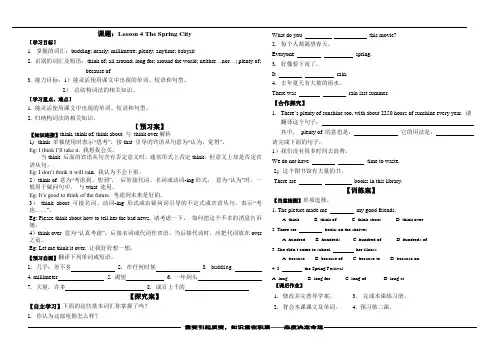
量变引起质变,知识重在积累——态度决定命运课题:Lesson 4 The Spring City【学习目标】1. 掌握的词汇:budding; nearly; millimetre; plenty; anytime; babysit2. 识别的词汇及短语:think of; all around; long for; around the world; neither …nor …; plenty of;because of3. 能力目标:1)能灵活使用课文中出现的单词、短语和句型。
2) 总结构词法的相关知识。
【学习重点、难点】1. 能灵活使用课文中出现的单词、短语和句型。
2. 归纳构词法的相关知识。
【预习案】【知识连接】think, think of, think about 与 think over 解析1) think 单独使用时表示“思考”,接that 引导的宾语从句意为“认为、觉得”。
Eg: I think I’ll take it. 我想我会买。
当think 后面的宾语从句含有否定意义时,通常形式上否定think ,但意义上却是否定宾语从句。
Eg: I don’t think it will ra in. 我认为不会下雨。
2)think of 意为“考虑到、想到”, 后常接代词、名词或动词-ing 形式; 意为“认为”时,一般用于疑问句中, 与what 连用。
Eg: It’s good to think of the future. 考虑到未来是好的。
3) think about 可接名词、动词-ing 形式或由疑问词引导的不定式或宾语从句,表示“考虑……”。
Eg: Please think about how to tell her the bad news. 请考虑一下, 如何把这个不幸的消息告诉她。
4)think over 意为“认真考虑”,后接名词或代词作宾语。
当后接代词时,应把代词放在over 之前。
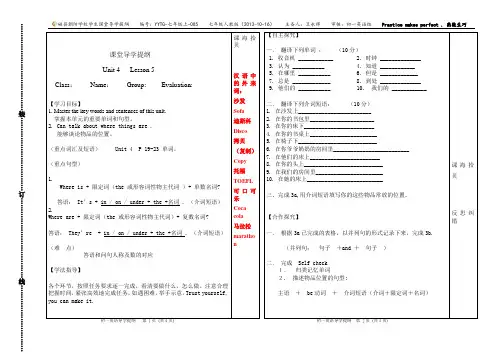
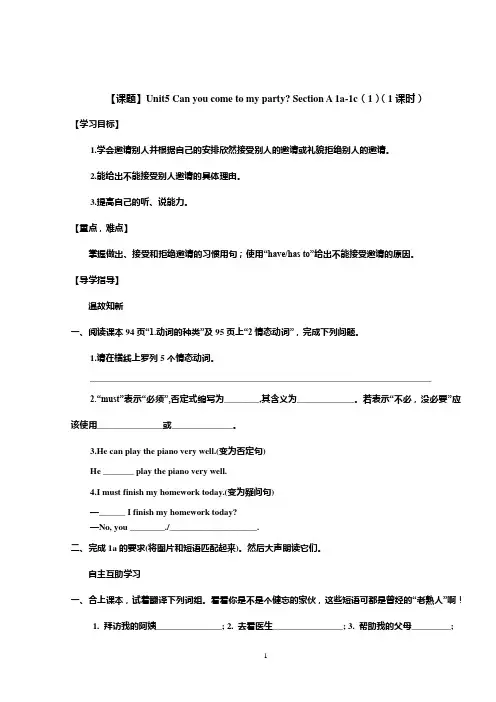
【课题】Unit5 Can you come to my party? Section A 1a-1c(1)(1课时)【学习目标】1.学会邀请别人并根据自己的安排欣然接受别人的邀请或礼貌拒绝别人的邀请。
2.能给出不能接受别人邀请的具体理由。
3.提高自己的听、说能力。
【重点,难点】掌握做出、接受和拒绝邀请的习惯用句;使用“have/has to”给出不能接受邀请的原因。
【导学指导】温故知新一、阅读课本94页“1.动词的种类”及95页上“2情态动词”,完成下列问题。
1.请在横线上罗列5个情态动词。
______________________________________________________________________________2.“must”表示“必须”,否定式缩写为________,其含义为_____________。
若表示“不必,没必要”应该使用_______________或______________。
3.He can play the piano very well.(变为否定句)He _______ play the piano very well.4.I must finish my homework today.(变为疑问句)—______ I finish my homework today?—No, you ________./____________________.二、完成1a的要求(将图片和短语匹配起来)。
然后大声朗读它们。
自主互助学习一、合上课本,试着翻译下列词组。
看看你是不是个健忘的家伙,这些短语可都是曾经的“老熟人”啊!1. 拜访我的阿姨_______________;2. 去看医生________________;3. 帮助我的父母_________;4. 上钢琴课___________________;5. 为考试学习_______________;6.在星期六下午______________。
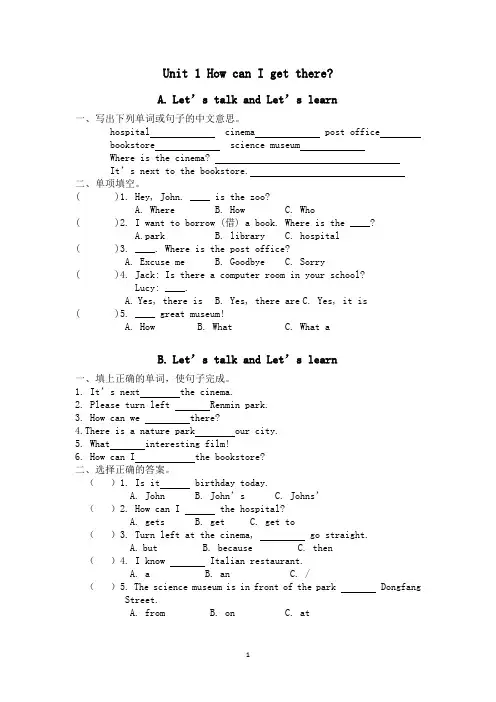
Unit 1 How can I get there?A.Let’s talk and Let’s learn一、写出下列单词或句子的中文意思。
hospital cinema post office bookstore science museumWhere is the cinema?It’s next to the bookstore.二、单项填空。
( )1. Hey, John. ____ is the zoo?A. WhereB. HowC. Who( )2. I want to borrow (借) a book. Where is the ____?A.parkB. libraryC. hospital( )3. ____. Where is the post office?A. Excuse meB. GoodbyeC. Sorry( )4. Jack: Is there a computer room in your school?Lucy: ____.A.Yes, there isB. Yes, there areC. Yes, it is( )5. ____ great museum!A. HowB. WhatC. What aB.Let’s talk and Let’s learn一、填上正确的单词,使句子完成。
1. It’s next the cinema.2. Please turn left Renmin park.3. How can we there?4.There is a nature park our city.5. What interesting film!6. How can I the bookstore?二、选择正确的答案。
()1. Is it birthday today.A. JohnB. John’sC. Johns’()2. How can I the hospital?A. getsB. getC. get to()3. Turn left at the cinema, go straight.A.butB. becauseC. then()4. I know Italian restaurant.A. aB. anC. /()5. The science museum is in front of the park Dongfang Street.A. fromB. onC. atB.Read and write一、根据句意,选择正确的单词,补全句子。
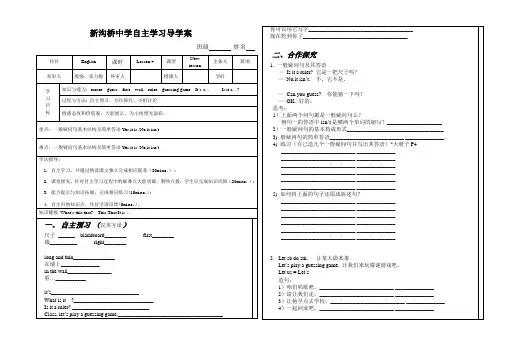
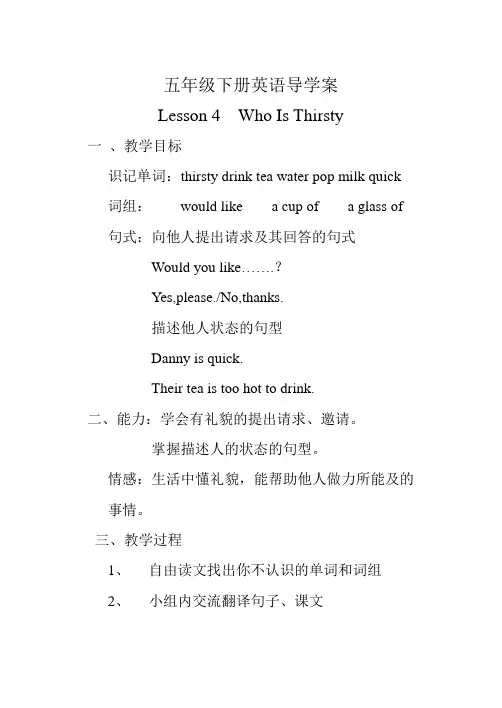
五年级下册英语导学案
Lesson 4 Who Is Thirsty
一、教学目标
识记单词:thirsty drink tea water pop milk quick 词组:would like a cup of a glass of 句式:向他人提出请求及其回答的句式
Would you like…….?
Yes,please./No,thanks.
描述他人状态的句型
Danny is quick.
Their tea is too hot to drink.
二、能力:学会有礼貌的提出请求、邀请。
掌握描述人的状态的句型。
情感:生活中懂礼貌,能帮助他人做力所能及的事情。
三、教学过程
1、自由读文找出你不认识的单词和词组
2、小组内交流翻译句子、课文
3、全班交流,找出本课的生词和词组。
四、训练巩固
结组练习
A: Who is thirty ?
B: I am /I am thirty too. /Me ,too.
A: What would you like to drink? Would you like some tea? Some water? Or some milk?
B: Some tea, please. /No,thanks.
A:The tea is too hot to drink.
B:Now I can drink my tea.
五、展示交流
全组选出代表在班上展示,选出优秀组。
六、家庭作业
写一组和同学的对话,要求把你手中的饮料送出去。
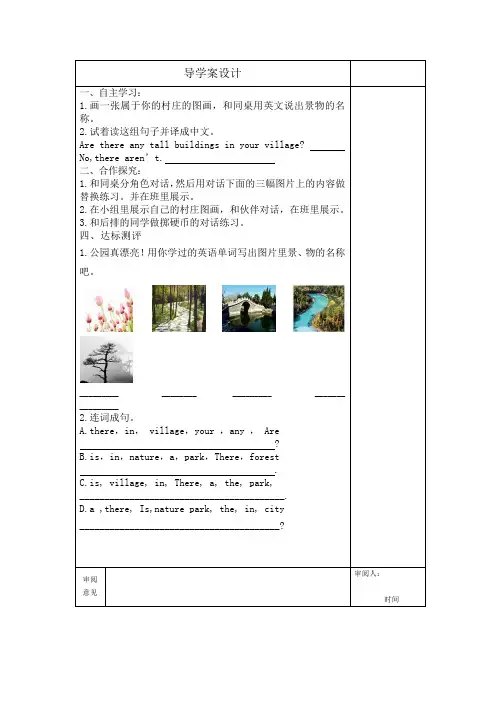
2021-2022年《Lesson 4 Shoes and Socks》导学案一.教学目标:1.能听懂、会说、认读并拼写下列词汇:shoes, socks, dress, shorts.2.能能听懂、会说、认读并口头运用下列用语和句子:Is this his +单数?Is this her +单数?Are these his +复数?Are these her +复数?二、教学重、难点:三、学习流程:(一)连词成句。
1. wearing is a he coat(.)_________________________________________2. these gloves are your (?)_________________________________________3. is this scarf my ( . )_________________________________________4. your are boots these ( ? )__________________________________________(二)听录音,读课文,完成下列问题。
1.听录音,跟读第一部分,学习新词汇。
独立完成英汉互译。
鞋__________ 袜子__________ 连衣裙_______ 短裤_________ 2. 听录音,学习第三部分。
你能读出并拼写出下面的单词吗?这个______ 这些________跟读,注意语音语调。
理解对话并回答下列问题:(1)Are these Danny’s shorts? __________________(2)Is this Danny’s dress? _____________________________________________________________________________________________ ____________________________________________________________________________________________________________________________ ___________________________________________________________________________ ________________________________(四)我收获,我快乐!通过本节的学习我学会了:达标检测一.看图填词。
四年级上册英语导学案-Unit 5 Safety Lesson 2|人教(新起点)教学目标1.能听懂并答出本课的语音、语调、情感和语言。
2.能正确地朗读课本中的对话和短文。
3.能正确地模仿老师和同学们进行口语对话,及时反馈修正错误。
4.能正确地使用词汇:ladder、drive、look、cross、ride等。
5.能够学会有关安全的知识,加强自我保护和预防意识。
教学重点1.学会使用词汇:ladder、drive、look、cross、ride等。
2.提高学生们的口语交流能力。
3.加强安全意识,提高自我保护能力。
教学准备课本、黑板、彩笔、游戏卡片等。
教学过程Step 1 导入新知1.与学生们打招呼并询问他们的近况。
2.本课主题为安全,请学生可以问问自己朋友或家长,他们最常说的安全话是什么。
Step 2 新课预测师生一起回忆上节课的知识,并简单复习一下课文。
老师可问几个小朋友问题,但应尽量使用学生英语回答,激发学生们的学习兴趣。
Step 3 学习新知1.先让学生们观看PPT图片,直观地了解新知识ladder(梯子)以及如何使用梯子将灯泡安装在天花板上。
2.让学生听录音,听两遍,重点理解其语句和语调。
然后请几位同学来模仿一遍。
3.让学生们阅读课文,理解并极力模仿语调。
4.翻译新词汇,并提供语境练习。
Step 4 活动安排1.教师和学生一起或小组分配角色进行对话,练习是使用生词 ladder。
2.课堂游戏:Magic words (魔法词语)。
老师会在黑板上写下一些单词(包括课文中的字词和第3步中的字词),学生们依次用英语说出相应的单词,并在黑板上涂掉。
3.解释“cross the road”,并让学生们在课间或回家路上多留意,小心过马路。
Step 5 课堂总结1.请几位同学总结本节课所学到的新知识。
2.对学生的表现和进步进行肯定并表扬。
教师提醒这节课的重点是帮助学生们提高口语交流能力、学会使用梯子(ladder)、锻炼学生对安全话题的理解和自我保护能力。
《Lesson5》导学案一、学习目标1、掌握课文中的重点词汇和短语,如_____、_____、_____等。
2、理解课文的主要内容,能够准确概括段落大意。
3、熟练运用课文中的句型进行交流和表达,如_____、_____、_____等。
4、培养阅读理解和分析问题的能力,提高语言综合运用水平。
二、学习重难点1、重点(1)重点词汇和短语的记忆与运用,包括词性、词义和搭配。
(2)课文中的关键句型的结构和用法,能够举一反三进行造句。
2、难点(1)对课文中复杂句子的理解和翻译,分析句子成分。
(2)如何将所学知识运用到实际的语言交流中,避免中式英语的表达。
三、学习方法1、预习(1)通读课文,标记出生词和不理解的句子。
(2)查阅词典,了解生词的读音、词性和词义。
(3)尝试翻译课文,初步理解课文大意。
2、课堂学习(1)认真听讲,跟随老师的思路,积极参与课堂互动。
(2)做好笔记,记录重点知识和老师强调的要点。
(3)小组讨论,与同学交流学习心得,共同解决问题。
3、复习(1)复习课文,背诵重点段落和句子。
(2)完成课后练习题,巩固所学知识。
(3)进行自我检测,查漏补缺,及时发现问题并解决。
四、学习过程1、词汇学习(1)学习课文中出现的生词,如_____,通过例句理解其用法。
例句:_____(2)学习短语,如_____,掌握其常见搭配。
搭配:_____2、课文理解(1)快速阅读课文,回答以下问题:文章的主题是什么?主要人物有哪些?(2)仔细阅读课文,概括每个段落的大意。
第一段:_____第二段:_____3、句型学习(1)学习课文中的重点句型,如_____。
结构:_____用法:_____(2)模仿句型进行造句练习,加强对句型的掌握。
4、语法学习(1)分析课文中出现的语法点,如_____。
规则:_____示例:_____(2)通过练习巩固语法知识,如填空、选择等题型。
5、拓展练习(1)根据课文内容进行角色扮演,模拟实际场景进行对话。
《Lesson5》导学案一、学习目标1、掌握本节课的重点词汇和短语,如_____、_____、_____等。
2、理解并能够运用本节课的重点句型,如:_____ 、_____ 。
3、能够听懂与本节课主题相关的听力材料,并获取关键信息。
4、能够阅读并理解与本节课主题相关的文章,提高阅读理解能力。
5、能够运用所学知识进行简单的口语交流和书面表达,描述相关场景或事件。
二、学习重难点1、重点(1)词汇:_____ 、_____ 、_____ 等的读音、拼写和用法。
(2)句型:_____ 、_____ 的结构和用法。
2、难点(1)对某些词汇在特定语境中的灵活运用。
(2)如何准确运用所学句型进行复杂的表达。
三、学习方法1、预习在学习新内容之前,预习课文,标记出生词和不理解的句子,尝试通过查字典或其他方式解决部分问题。
2、课堂学习认真听讲,积极参与课堂活动,与老师和同学互动,及时提出疑问。
3、复习课后及时复习所学内容,完成相关练习题,巩固知识点。
四、学习过程1、词汇学习(1)教师领读重点词汇,学生跟读,注意纠正发音。
(2)学生分组讨论词汇的用法,通过造句加深理解。
2、句型学习(1)教师讲解重点句型的结构和用法,举例说明。
(2)学生模仿例句进行句型操练,互相检查。
3、听力训练(1)播放听力材料,学生认真听,完成相关练习。
(2)再次播放听力材料,核对答案,针对错误进行分析和讲解。
4、阅读训练(1)学生自主阅读课文,理解文章大意。
(2)教师提出问题,学生回答,共同探讨文章中的重点和难点。
5、口语交流(1)根据课文内容,创设相关场景,学生进行角色扮演,进行口语交流。
(2)小组讨论,分享自己的观点和经历,运用所学知识表达。
6、书面表达(1)布置写作任务,要求学生运用所学知识写一篇短文。
(2)学生完成后,教师进行批改和点评,提出改进意见。
五、巩固练习1、完成课本上的练习题,巩固所学知识。
2、背诵重点词汇和句型。
3、用所学知识写一篇关于_____的短文。